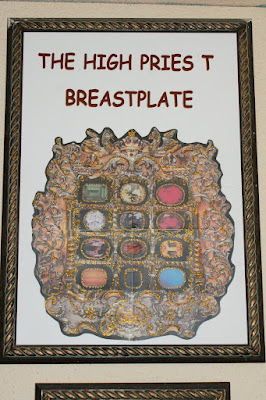First, a showcase of various rough gemstones. I can't read the Hebrew labels, but I believe there are some pieces of amethyst and opal and quartz in here.

It was not a pure shopping trip, fortunately, for we did learn about the High Priest's Breastplate. Among the other priestly vestments, the breastplate is first described in the book of Exodus, as follows:
You shall make a breastpiece of judgement, in skilled work; you shall make it in the style of the ephod; of gold, of blue and purple and crimson yarns, and of fine twisted linen you shall make it. It shall be square and doubled, a span in length and a span in width. You shall set in it four rows of stones. A row of carnelian,* chrysolite, and emerald shall be the first row; and the second row a turquoise, a sapphire,* and a moonstone; and the third row a jacinth, an agate, and an amethyst; and the fourth row a beryl, an onyx, and a jasper; they shall be set in gold filigree. There shall be twelve stones with names corresponding to the names of the sons of Israel; they shall be like signets, each engraved with its name, for the twelve tribes. You shall make for the breastpiece chains of pure gold, twisted like cords; and you shall make for the breastpiece two rings of gold, and put the two rings on the two edges of the breastpiece. You shall put the two cords of gold in the two rings at the edges of the breastpiece; the two ends of the two cords you shall attach to the two settings, and so attach it in front to the shoulder-pieces of the ephod. You shall make two rings of gold, and put them at the two ends of the breastpiece, on its inside edge next to the ephod. You shall make two rings of gold, and attach them in front to the lower part of the two shoulder-pieces of the ephod, at its joining above the decorated band of the ephod. The breastpiece shall be bound by its rings to the rings of the ephod with a blue cord, so that it may lie on the decorated band of the ephod, and so that the breastpiece shall not come loose from the ephod. So Aaron shall bear the names of the sons of Israel in the breastpiece of judgement on his heart when he goes into the holy place, for a continual remembrance before the Lord. In the breastpiece of judgement you shall put the Urim and the Thummim, and they shall be on Aaron’s heart when he goes in before the Lord; thus Aaron shall bear the judgement of the Israelites on his heart before the Lord continually. (Exodus 28:15-30, NRSV)
Aaron was Moses' brother and was the first High Priest of the Israelites after their escape from Egypt. When Aaron died, only his descendants could become high priests, and thus another name for the high priests was "sons of Aaron." Because the High Priest was the people's representative before God, it was considered the most glorious of all positions, and the High Priest's vestments were designed for glory and beauty.
The breastplate was of great importance because God used it to reveal the divine will to the Chosen People. It was a type of oracle, the means by which God responded to the High Priest's inquiries. Scholars believe the process went something like this: Faced with an important decision, a person would submit his or her request to the High Priest, who would then stand before the lampstand near the altar. He would hold the Urim in one hand and the Thurim in the other (these were sacred, some believe miraculous, stones or jewels, the Urim representing light and excellence and the Thummim signifying perfection and completion). The candlelight from the lampstand would reflect from the Urim and Thummim onto the breastplate's stones. The people believed that God's breath caused the candle flames to flicker, altering the angle with which the light would shine onto the Urim and Thummim, and from them onto the stones of the breastplate. Twenty-four combinations of reflection were possible, corresponding to the letters of the Hebrew alphabet, so the flashes of light could produce strings of letters, allowing God to communicate directly to the High Priest.

Which stones were set into the breastplate? This is an age-old question. Although the Hebrew names of the stones are well documented, scholars have never agreed upon their translation. The scripture passage cited above gives one possible grouping, but here is another, listed with the corresponding tribe:
Judah: Sardius (red)
Issachar: Topaz (pale green)
Zebulon: Carbuncle (deep red)
Reuben: Emerald (green)
Simeon: Sapphire (deep blue)
Gad: Diamond (transparent)
Ephraim: Ligure (dull red)
Manasseh: Agate (gray)
Benjamin: Amethyst (purple)
Dan: Beryl (bluish green)
Asher: Onyx (bluish white)
Naphtali: Jasper (green)
The stones were set in four rows, three per row, and the name of the tribe was engraved upon its stone.

Finally, I had to photograph the nails of our tour guide. This was some amazing work that must have taken a number of hours--and must have been incredibly expensive. I guess when you can't wear any more diamond rings or bracelets or earrings or necklaces, it makes sense to attach the gems directly to your nails!

1 comment:
I also agree with the following statement that this is a pure shopping trip .the diamond which shown in the picture is very rare as per the information it's very difficult to sort out the problem that which can be a precious diamond, because every dimond it has it's own story.
Diamond VA
Post a Comment